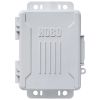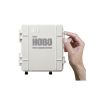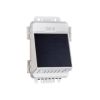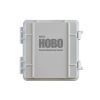Onset 4-20mA Input Adapter
Features
- Plug-in modular connector for easy interface with HOBO stations
- HOBO RX3000 and U30 stations have room for two adapters
- USB Micro Station and MicroRX Station requires consolidator box and extension cable
- Expedited repair and warranty service
- Lifetime technical support
- More
Overview
The Onsite 12-bit 4-20 mA Input Adapter interfaces with any sensor and provides a 4-20 mA signal to connect to smart sensor-compatible HOBO stations. This adapter features both a non-switched input and a battery-saving switched input that extends the life of external batteries. It also provides a trigger signal for controlling power to attached external sensors while offering digital filtering, which improves measurement accuracy with 32 readings/sample and 60 Hz noise rejection.
Benefits
- 12-bit resolution
- Digital filtering improves measurement accuracy with 32 readings/sample—4-• 20 mA adapter has 60 Hz noise rejection
- Measurement averaging over logging interval further enhances accuracy
- Plug-in modular connector for easy interface with HOBO stations
- Screw terminal for connecting to sensors
- HOBO RX3000 and U30 stations have room for two adapters
- Use with HOBO USB Micro Station and HOBO MicroRX Station requires Smart Sensor Consolidator Box (S-ADAPT-6) and an extension cable
- Represents one data input channel
Measurement range: 4-20 mA (measures down to 0 mA to detect error condition)
Operating temperature range: -40° to 75°C (-40° to 167°F)
Accuracy: ±40 µA ±0.3% of reading (over operating temperature range)
Resolution: ±4.93 µA
Input impedance: 124 ohms (differential input)
Sensor trigger source: Voltage: 2.5 V ±2.4%; maximum current: 1 mA
Warm-up time: 300 ms ±3% (fixed)
Measurement time: 16.6 ms ±3% to filter out 60 Hz noise
Cable length: 14 cm (5.5 inch)
In The News
Data-Driven Advocacy on the Lower Deschutes River
Like many freshwater environments, the Deschutes River in Oregon is under pressure from development, pollution, and climate change. Many rivers, streams and lakes in the Deschutes Basin do not meet Oregon water quality standards –where state water quality monitoring assesses levels of bacteria, pH, dissolved oxygen, temperature, and fine sediment. Hannah Camel is the Water Quality Coordinator for the Deschutes River Alliance (DRA), a non-profit organization that focuses on the health of the lower 100 miles of the Deschutes River–the area most affected by human intervention. As a data-driven organization, the DRA has benefited from the installation of two NexSens X2 data loggers.
Read MoreExpanding the Port Everglades: Real-Time Monitoring of Water Quality Conditions from Planned Dredging Operation
The Port Everglades in Broward County, Florida, serves large trade vessels and cruiseliners and incoming and outgoing recreational boaters. However, as cargo ships become larger, the port must expand. A dredging project led by the US Army Corps of Engineers will substantially deepen and widen the port's navigation channel to accommodate larger Panamax cargo ships and modern cruise liners. As a result of this project, a large amount of sediment will be displaced into the water column. This suspended sediment may settle outside of the project area, burying benthic organisms like corals, and possibly carrying harmful particulates to other regions. [caption id="attachment_39497" align="aligncenter" width="2560"] A CB-950 and CB-25 deployed on site at Port Everglades.
Read MoreIt’s Time to React to Water Quality: Proteus Multiparameter Probe aboard NexSens Buoy
Water quality monitoring is essential for safeguarding public health, protecting ecosystems, and ensuring the sustainability of water resources. Contaminants such as industrial pollutants, agricultural runoff, and sewage discharge can severely impact aquatic life and pose serious risks to human health if left unchecked. Traditionally, water quality monitoring has been a slow and labor-intensive process, requiring samples to be collected, transported to a lab, and analyzed—a process that can take days. However, with the advancement of real-time sensor technology, environmental agencies, researchers, and industries can now monitor water quality instantly.
Read More
















